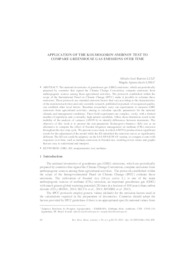Application of the Kolmogorov-Smirnov test to compare greenhouse gas emissions over time.
Application of the Kolmogorov-Smirnov test to compare greenhouse gas emissions over time.
Author(s): LUIZ, A. J. B.; LIMA, M. A. de
Summary: Abstract: The national inventories of greenhouse gas (GHG) emissions, which are periodically prepared by countries that signed the Climate Change Convention, compute emissions from anthropogenic sources among them agricultural activities. The protocols established within the scope of the International Panel on Climate Change (IPCC) make it possible to estimate these emissions. These protocols use standard emission factors that vary according to the characteristics of the monitored activities and only scientific research, published in journals of recognized quality, can establish other local factors. Brazilian researchers carry out experiments to measure GHG emissions from agricultural activities, aiming to calculate specific parameters for the national climatic and management conditions. These field experiments are complex, costly, with a limited number of repetitions and, eventually, high natural variability. Often, these limitations result in the inability of the analysis of variance (ANOVA) to identify differences between treatments. The objective of this work is to present the non-parametric Kolmogorov-Smirnov (KS) test as an alternative to compare the effect of flooded irrigation management on methane (CH4) emission throughout the rice crop cycle. We present a case study in which ANOVA produced non-significant results for the adjustment of the model while the KS identified the emission curves as significantly different. The KS test could be adapted, via the SAS NPAR1WAY routine, to compare events with responses over time, such as methane emissions in flooded rice, resulting in test values and graphs that are easy to understand and interpret.
Publication year: 2021
Types of publication: Journal article
Unit: Embrapa Environment
Observation
Some of Embrapa's publications are published as ePub files. To read them, use or download one of the following free software options to your computer or mobile device. Android: Google Play Books; IOS: iBooks; Windows and Linux: Calibre.
Access other publications
Access the Agricultural Research Database (BDPA) to consult Embrapa's full library collection and records.
Visit Embrapa Bookstore to purchase books and other publications sold by Embrapa.

